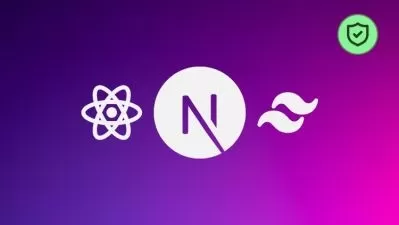Zero to Hero NextJS 14 course for real project development
Ranjan Pandey
4:31:51
Description
Learn NextJS 14 and Bootstrap 5 with practical examples after this course you will be ready to build real world projects
What You'll Learn?
- You will learn to create new next js 14.0 application
- You will learn to use Bootstrap5 and next js 14.0 together
- You will learn about working of Next js app
- You will learn about app router in Next JS
- You will learn how to apply animation
- You will learn when to use Server component and when to use Client component
- You will learn how to use Client component and Server components together
- You will learn to develop REST API's in Next JS
- You will also learn to consume REST API in your NEXT JS project
- You will also learn to make calls to other microservices.
Who is this for?
What You Need to Know?
More details
DescriptionIn this course you will learn NextJS 14 along with Bootstrap5. You will learn different NextJS concepts like routing, API development, making calls to other microservices, Client side rendering, Server side rendering, combining client side and server side components. You will also learn various techniques of passing data between components and how to use bootstrap and animation. After this course you will ready to work in NextJS 14 in any company and also build any real world project.
REACT JS & NEXT JS are hot in the Job Market - Easily get Job or Upgrade your salary by switching to new Job
Following are the topics you will learn in this course:
What is NextJS
NextJS Vs ReactJS
Creating NextApp understanding its working
Adding Fonts, Icons, Bootstrap, Animations
Client side Vs Server side rendering
Different types of Templates & Layouts in Next JS
Routing - File based & Dynamic
Passing data between pages
Best way of using client and server components together in real time situation
Making REST API calls from UI and showing on response data on UI
Developing REST API’s like GET POST PUT DELETE
Validation of DATA
Calling other API from our Backend API - Microservice
Understanding about NoSQL, MongoDB and Mongoose
Integrating MongoDB to our Next App
Updating our REST API to connect to Database and store data using Mongoose.
Complete Handson
Project based
Source code provided
Step by Step explanation of concepts with handson practical examples.
Next.js is a powerful and popular open-source React framework that enables developers to build modern and efficient web applications. Launched by Vercel, Next.js simplifies the React development process by providing a robust structure and a range of built-in features.
One of Next.js' key strengths is its support for server-side rendering (SSR) and static site generation (SSG). This means that web pages can be pre-rendered on the server, enhancing performance and search engine optimization. Additionally, Next.js supports client-side rendering, offering flexibility in choosing the rendering method that best suits a project's needs.
The framework's automatic code splitting allows for optimized loading times, ensuring that only the necessary code is sent to the client. With a strong focus on developer experience, Next.js provides a wealth of features, including hot module replacement, automatic routing, and a plugin system for extensibility.
Next.js is a feature-rich React framework that simplifies the development of web applications. Some of its key features include:
Server-Side Rendering (SSR): Next.js enables SSR, allowing web pages to be pre-rendered on the server before being sent to the client. This enhances performance and improves search engine optimization.
Static Site Generation (SSG): In addition to SSR, Next.js supports SSG, where pages can be generated at build time. This approach is useful for content that doesn't change frequently, resulting in faster page loads.
Automatic Code Splitting: Next.js automatically splits code into smaller chunks, sending only the necessary code to the client. This leads to improved loading times and a better user experience, especially on slower networks.
Client-Side Rendering (CSR): While SSR and SSG are emphasized, Next.js also supports traditional client-side rendering when needed, offering flexibility in choosing the rendering approach based on specific use cases.
Routing: Next.js has automatic route handling based on the file system, making it intuitive for developers. Custom routes can also be configured easily, allowing for more complex application structures.
API Routes: Next.js simplifies the creation of API endpoints by providing a straightforward way to build serverless functions within the project. This facilitates seamless communication between the client and server.
Hot Module Replacement (HMR): Developers benefit from HMR, which allows for real-time code updates without requiring a full page refresh. This feature speeds up the development process and enhances the developer experience.
Middleware Support: Next.js supports middleware, allowing developers to execute custom logic before handling a request. This is particularly useful for tasks like authentication and data fetching.
Built-in CSS Support: Next.js provides built-in support for styling with CSS, whether it's traditional CSS, CSS Modules, or popular CSS-in-JS solutions like styled-components.
TypeScript Support: Next.js seamlessly integrates with TypeScript, providing static typing for enhanced code quality and developer productivity.
Who this course is for:
- Anyone who wants to develop fullstack applications with NextJS 14.0
In this course you will learn NextJS 14 along with Bootstrap5. You will learn different NextJS concepts like routing, API development, making calls to other microservices, Client side rendering, Server side rendering, combining client side and server side components. You will also learn various techniques of passing data between components and how to use bootstrap and animation. After this course you will ready to work in NextJS 14 in any company and also build any real world project.
REACT JS & NEXT JS are hot in the Job Market - Easily get Job or Upgrade your salary by switching to new Job
Following are the topics you will learn in this course:
What is NextJS
NextJS Vs ReactJS
Creating NextApp understanding its working
Adding Fonts, Icons, Bootstrap, Animations
Client side Vs Server side rendering
Different types of Templates & Layouts in Next JS
Routing - File based & Dynamic
Passing data between pages
Best way of using client and server components together in real time situation
Making REST API calls from UI and showing on response data on UI
Developing REST API’s like GET POST PUT DELETE
Validation of DATA
Calling other API from our Backend API - Microservice
Understanding about NoSQL, MongoDB and Mongoose
Integrating MongoDB to our Next App
Updating our REST API to connect to Database and store data using Mongoose.
Complete Handson
Project based
Source code provided
Step by Step explanation of concepts with handson practical examples.
Next.js is a powerful and popular open-source React framework that enables developers to build modern and efficient web applications. Launched by Vercel, Next.js simplifies the React development process by providing a robust structure and a range of built-in features.
One of Next.js' key strengths is its support for server-side rendering (SSR) and static site generation (SSG). This means that web pages can be pre-rendered on the server, enhancing performance and search engine optimization. Additionally, Next.js supports client-side rendering, offering flexibility in choosing the rendering method that best suits a project's needs.
The framework's automatic code splitting allows for optimized loading times, ensuring that only the necessary code is sent to the client. With a strong focus on developer experience, Next.js provides a wealth of features, including hot module replacement, automatic routing, and a plugin system for extensibility.
Next.js is a feature-rich React framework that simplifies the development of web applications. Some of its key features include:
Server-Side Rendering (SSR): Next.js enables SSR, allowing web pages to be pre-rendered on the server before being sent to the client. This enhances performance and improves search engine optimization.
Static Site Generation (SSG): In addition to SSR, Next.js supports SSG, where pages can be generated at build time. This approach is useful for content that doesn't change frequently, resulting in faster page loads.
Automatic Code Splitting: Next.js automatically splits code into smaller chunks, sending only the necessary code to the client. This leads to improved loading times and a better user experience, especially on slower networks.
Client-Side Rendering (CSR): While SSR and SSG are emphasized, Next.js also supports traditional client-side rendering when needed, offering flexibility in choosing the rendering approach based on specific use cases.
Routing: Next.js has automatic route handling based on the file system, making it intuitive for developers. Custom routes can also be configured easily, allowing for more complex application structures.
API Routes: Next.js simplifies the creation of API endpoints by providing a straightforward way to build serverless functions within the project. This facilitates seamless communication between the client and server.
Hot Module Replacement (HMR): Developers benefit from HMR, which allows for real-time code updates without requiring a full page refresh. This feature speeds up the development process and enhances the developer experience.
Middleware Support: Next.js supports middleware, allowing developers to execute custom logic before handling a request. This is particularly useful for tasks like authentication and data fetching.
Built-in CSS Support: Next.js provides built-in support for styling with CSS, whether it's traditional CSS, CSS Modules, or popular CSS-in-JS solutions like styled-components.
TypeScript Support: Next.js seamlessly integrates with TypeScript, providing static typing for enhanced code quality and developer productivity.
Who this course is for:
- Anyone who wants to develop fullstack applications with NextJS 14.0
User Reviews
Rating
Ranjan Pandey
Instructor's Courses
Udemy
View courses Udemy- language english
- Training sessions 59
- duration 4:31:51
- Release Date 2024/04/23











